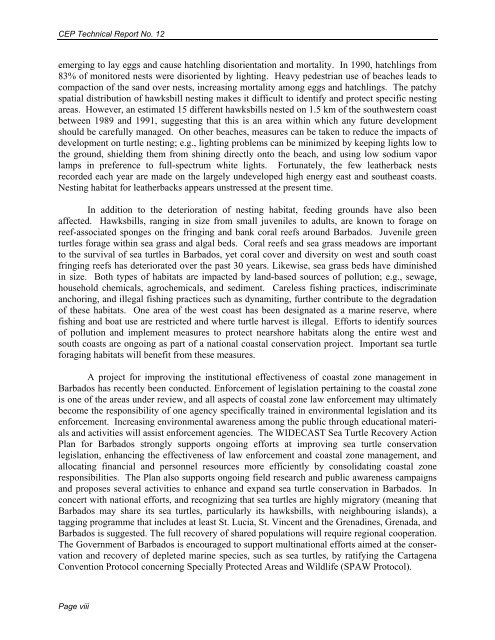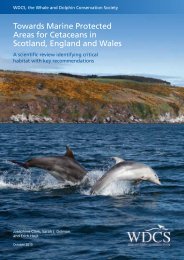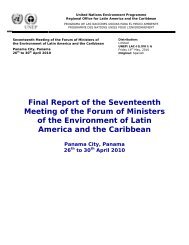Sea Turtle Recovery Action Plan for Barbados - WIDECAST
Sea Turtle Recovery Action Plan for Barbados - WIDECAST
Sea Turtle Recovery Action Plan for Barbados - WIDECAST
Create successful ePaper yourself
Turn your PDF publications into a flip-book with our unique Google optimized e-Paper software.
CEP Technical Report No. 12<br />
emerging to lay eggs and cause hatchling disorientation and mortality. In 1990, hatchlings from<br />
83% of monitored nests were disoriented by lighting. Heavy pedestrian use of beaches leads to<br />
compaction of the sand over nests, increasing mortality among eggs and hatchlings. The patchy<br />
spatial distribution of hawksbill nesting makes it difficult to identify and protect specific nesting<br />
areas. However, an estimated 15 different hawksbills nested on 1.5 km of the southwestern coast<br />
between 1989 and 1991, suggesting that this is an area within which any future development<br />
should be carefully managed. On other beaches, measures can be taken to reduce the impacts of<br />
development on turtle nesting; e.g., lighting problems can be minimized by keeping lights low to<br />
the ground, shielding them from shining directly onto the beach, and using low sodium vapor<br />
lamps in preference to full-spectrum white lights. Fortunately, the few leatherback nests<br />
recorded each year are made on the largely undeveloped high energy east and southeast coasts.<br />
Nesting habitat <strong>for</strong> leatherbacks appears unstressed at the present time.<br />
In addition to the deterioration of nesting habitat, feeding grounds have also been<br />
affected. Hawksbills, ranging in size from small juveniles to adults, are known to <strong>for</strong>age on<br />
reef-associated sponges on the fringing and bank coral reefs around <strong>Barbados</strong>. Juvenile green<br />
turtles <strong>for</strong>age within sea grass and algal beds. Coral reefs and sea grass meadows are important<br />
to the survival of sea turtles in <strong>Barbados</strong>, yet coral cover and diversity on west and south coast<br />
fringing reefs has deteriorated over the past 30 years. Likewise, sea grass beds have diminished<br />
in size. Both types of habitats are impacted by land-based sources of pollution; e.g., sewage,<br />
household chemicals, agrochemicals, and sediment. Careless fishing practices, indiscriminate<br />
anchoring, and illegal fishing practices such as dynamiting, further contribute to the degradation<br />
of these habitats. One area of the west coast has been designated as a marine reserve, where<br />
fishing and boat use are restricted and where turtle harvest is illegal. Ef<strong>for</strong>ts to identify sources<br />
of pollution and implement measures to protect nearshore habitats along the entire west and<br />
south coasts are ongoing as part of a national coastal conservation project. Important sea turtle<br />
<strong>for</strong>aging habitats will benefit from these measures.<br />
A project <strong>for</strong> improving the institutional effectiveness of coastal zone management in<br />
<strong>Barbados</strong> has recently been conducted. En<strong>for</strong>cement of legislation pertaining to the coastal zone<br />
is one of the areas under review, and all aspects of coastal zone law en<strong>for</strong>cement may ultimately<br />
become the responsibility of one agency specifically trained in environmental legislation and its<br />
en<strong>for</strong>cement. Increasing environmental awareness among the public through educational materials<br />
and activities will assist en<strong>for</strong>cement agencies. The <strong>WIDECAST</strong> <strong>Sea</strong> <strong>Turtle</strong> <strong>Recovery</strong> <strong>Action</strong><br />
<strong>Plan</strong> <strong>for</strong> <strong>Barbados</strong> strongly supports ongoing ef<strong>for</strong>ts at improving sea turtle conservation<br />
legislation, enhancing the effectiveness of law en<strong>for</strong>cement and coastal zone management, and<br />
allocating financial and personnel resources more efficiently by consolidating coastal zone<br />
responsibilities. The <strong>Plan</strong> also supports ongoing field research and public awareness campaigns<br />
and proposes several activities to enhance and expand sea turtle conservation in <strong>Barbados</strong>. In<br />
concert with national ef<strong>for</strong>ts, and recognizing that sea turtles are highly migratory (meaning that<br />
<strong>Barbados</strong> may share its sea turtles, particularly its hawksbills, with neighbouring islands), a<br />
tagging programme that includes at least St. Lucia, St. Vincent and the Grenadines, Grenada, and<br />
<strong>Barbados</strong> is suggested. The full recovery of shared populations will require regional cooperation.<br />
The Government of <strong>Barbados</strong> is encouraged to support multinational ef<strong>for</strong>ts aimed at the conservation<br />
and recovery of depleted marine species, such as sea turtles, by ratifying the Cartagena<br />
Convention Protocol concerning Specially Protected Areas and Wildlife (SPAW Protocol).<br />
Page viii

















